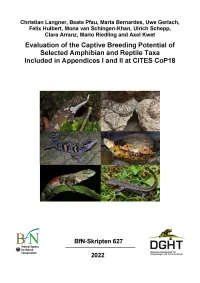BfN Schriften 627 - Evaluation of the Captive Breeding Potential of Selected Amphibian and Reptile Taxa Included in Appendices I and II at CITES CoP18
Beschreibung
The Convention on International Trade in Endangered Species of Wild Fauna and Flora (CITES) aims to ensure that international trade in specimens of wild animals and plants does not threaten the survival of the species affected by it. Whereas in the past mainly wild caught specimens were traded, currently more than 83% of traded reptiles and amphibians are claimed to be not of wild source. However, in some cases the source codes are highly questionable. While legal trade in captive bred specimens may contribute to species conservation, trade in wild specimens falsely labelled to be captive bred in order to circumvent trade restrictions, can be highly detrimental to wild population.
As such, the verification of the captive breeding of specimens in trade poses an increasing challenge to national and international CITES authorities and became of increasing significance for the work of international bodies of the convention. In order to check the plausibility of captive breeding, comprehensive information on the reproduction biology and husbandry requirements of the relevant species are crucial. However, especially for species that are rarely kept in captivity, newly listed in CITES, newly described to science or poorly studied, such relevant data may be lacking or not accessible. In Germany, there are numerous specialist keepers who have great experience in keeping and breeding of rare reptile and amphibian taxa, but in many cases the relevant data and experience remain unpublished.
The German Society of Herpetology and Herpetoculture (DGHT) was commissioned to com-pile relevant reproduction data for those reptile and amphibian taxa, which were included or uplisted in the CITES Appendices I and II at the previous CITES CoP18. Data was obtained from private keepers, commercial traders, zoological institutions and literature and – in addition to own expertise – used to develop the present guidance.
This guidance aims to assist CITES authorities in carrying out the plausibility check for the captive breeding of certain species and to improve the implementation of the CITES convention. In addition, the information provided herein can be used e.g., for conservation breeding programs or by scientists.
